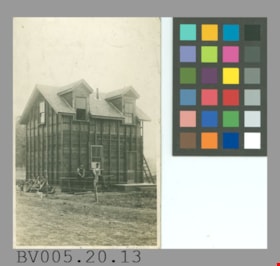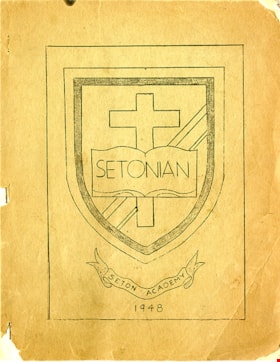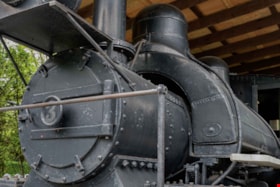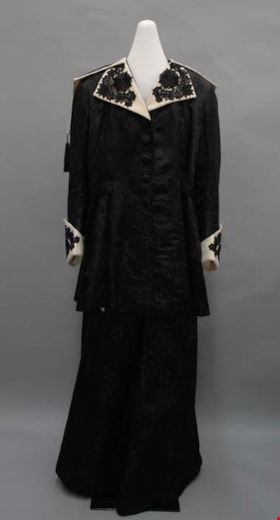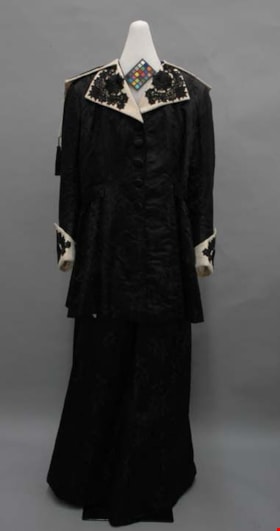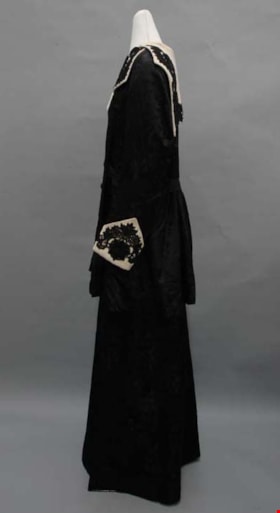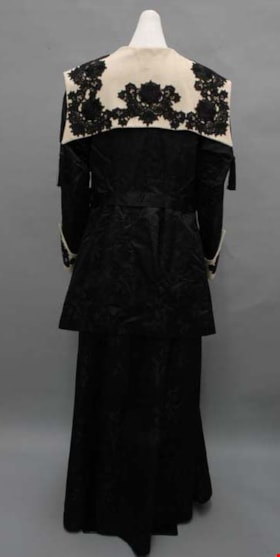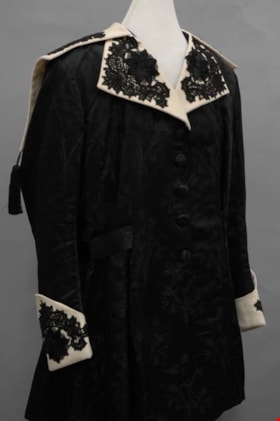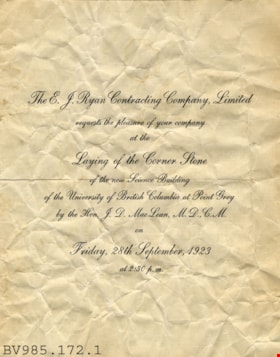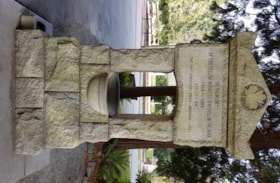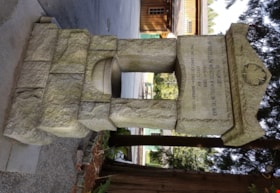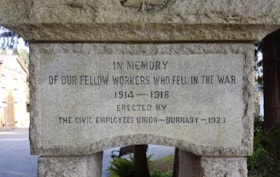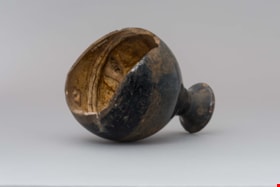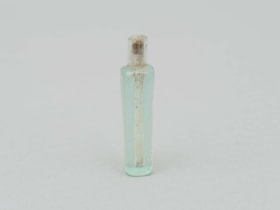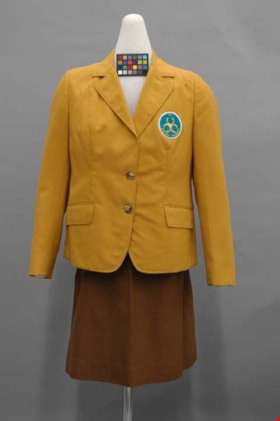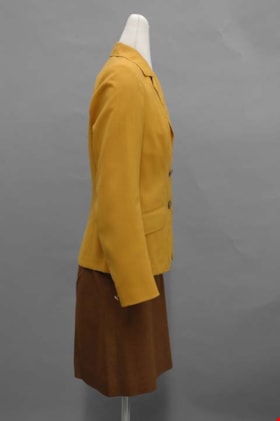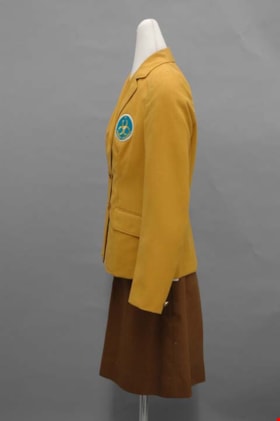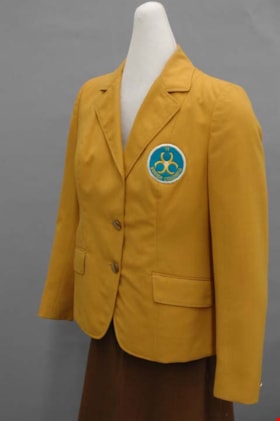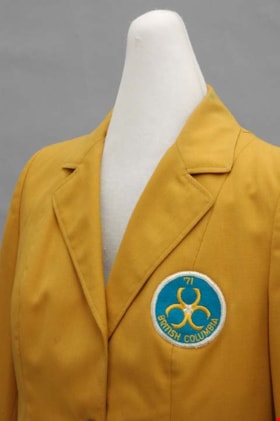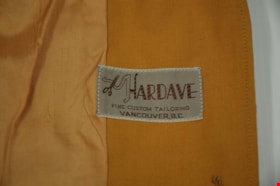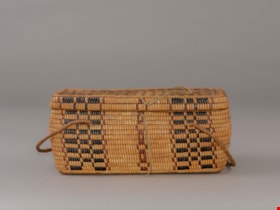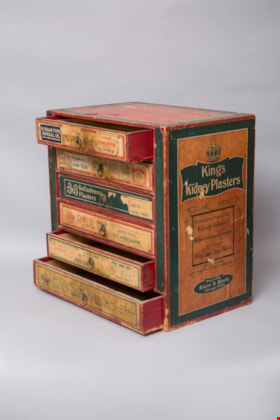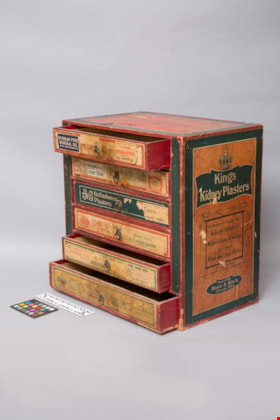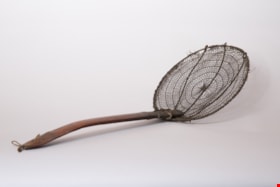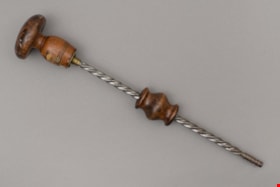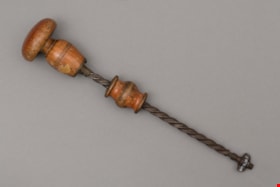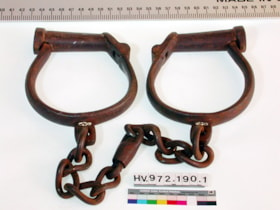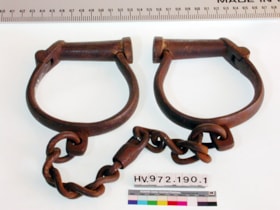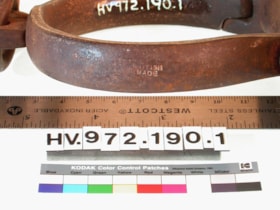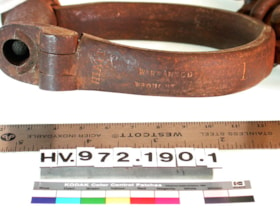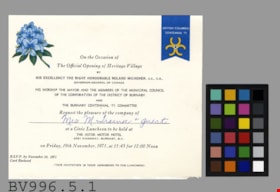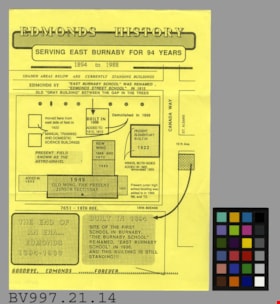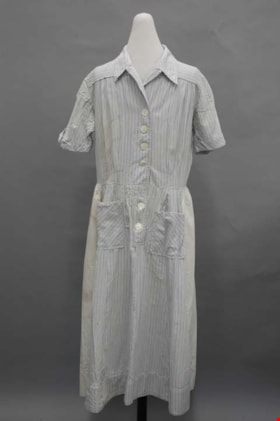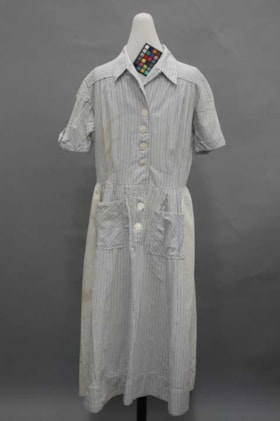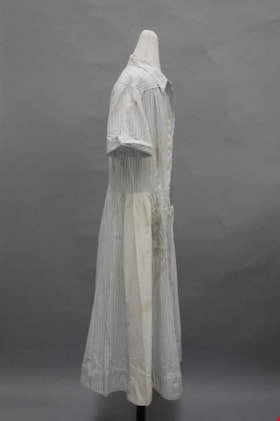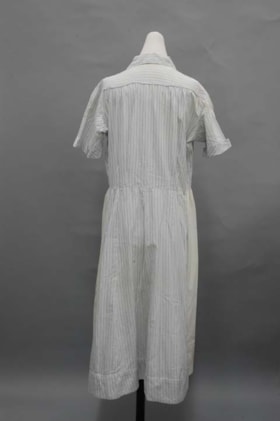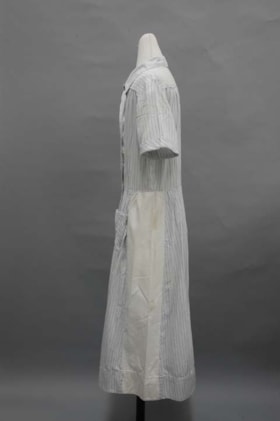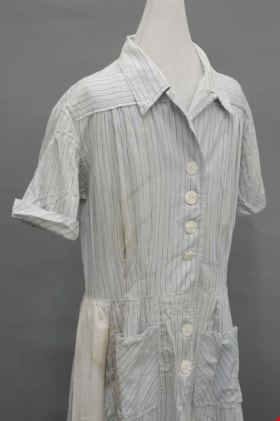Narrow Results By
Subject
- Advertising Medium 3
- Advertising Medium - Business Cards 2
- Advertising Medium - Flyer 1
- Advertising Medium - Poster 1
- Advertising Medium - Signs and Signboards 2
- Agriculture 2
- Agriculture - Dairy 2
- Agriculture - Farms 1
- Buildings 1
- Buildings - Residential 1
- Buildings - Residential - Houses 1
- Buildings - Schools 1
Person / Organization
- Bayntun, Charmaine "Sherrie" Yanko 5
- BC Society of Model Engineers (BCSME) 1
- Bridge Studios 1
- Burnaby Centennial '71 Committee 1
- Burnaby Village Museum 3
- Dairyland 2
- Edmonds Community School 1
- Fraser Valley Milk Producers Association 2
- Kensington Junior Secondary School 1
- Martin, Elmer Wilson 2
- National Drug Company 1
- Seton Academy 1
postcard
https://search.heritageburnaby.ca/link/museumartifact48364
- Repository
- Burnaby Village Museum
- Accession Code
- BV005.20.13
- Description
- Postcard: black and white photo, white border; vertical; shows two-storey wood-frame house during construction; two men sit on saw horse? in front, ladder visible against one side; wire fence between house and photographer; pencilled in border at bottom right, "1911 Burnaby"; no exact location identified; on reverse in black, "POST CARD"; short wavy line below and one extending about a centimetre down centre; at left, "CORRESPONDENCE", at right "ADDRESS"; dotted outline of rectangle at upper right; unused; soiled, stained and spotted; darkened around edges; creases; corners worn; impression of postmark, "11" very clear
- Classification
- Written Communication T&E - - Writing Media
- Object Term
- Postcard
- Marks/Labels
- 1911 Burnaby
- Colour
- Black
- White
- Country Made
- Canada
- Province Made
- British Columbia
- Site/City Made
- Burnaby
- Title
- 1911 Burnaby
- Publication Date
- 1911
- Subjects
- Documentary Artifacts
- Documentary Artifacts - Postcards
- Buildings
- Buildings - Residential
- Buildings - Residential - Houses
Images
newsletter
https://search.heritageburnaby.ca/link/museumartifact91534
- Repository
- Burnaby Village Museum
- Accession Code
- BV022.7.1
- Description
- Newsletter for Seton Academy; 23 mimeograhed pages plus cover; 3 staples binding along left edge; cover printed on beige construction paper. Cover includes illustration of coat of arms with cross and "SETONIAN" and ribbon banner below reading "SETON ACADEMY" with year "1948" beneath. Page 20 "Autographs" includes original signatures. Pages 21-23 include advertisements for local Burnaby businesses. Content of the newsletter includes dates between 1948 and 1959.
- Object History
- Seton Academy operated out of a mansion named "Overlynn" located at 3755 McGill Street in Burnaby Heights. "Overlynn" mansion was one of the first grandiose houses built in 1909. Seton Academy was a Catholic girls school that was run by the Sisters of Charity. The school and convent operated out of the mansion between 1927 and 1970. In 1970, the house was converted to a seniors home "Seton Villa" retaining the name from the school "Seton Academy". In 1995, the house was designated as a heritage building.
- Category
- 08. Communication Artifacts
- Classification
- Documentary Artifacts - - Other Documents
- Object Term
- Serial
- Colour
- Beige
- White
- Measurements
- Height 28 cm
- Width 11.5 cm
- Maker
- Seton Academy
- Country Made
- Canada
- Province Made
- British Columbia
- Site/City Made
- Burnaby
- Title
- Setonian Seton Academy
- Publication Date
- 1949
- Names
- Seton Academy
Images
locomotive
https://search.heritageburnaby.ca/link/museumartifact6255
- Repository
- Burnaby Village Museum
- Accession Code
- BV985.16.1
- Description
- The locomotive known as, "Old Curly", is a small construction or logging engine fitted with a saddle tank for water and with two sand domes on top. The engine has a 0-4-4 wheel layout, that is no front truck, 4 driving wheels and a 4 wheel truck under the cab. There is no tender wood or coal was stacked at the rear of the cab. This engine has been altered several times in its career. There is a layer of insulation (asbestos?) between the saddle tank and the boiler. Round pane of clear "headlight glass" located at AB106-GS-6 in June 2019
- Object History
- This locomotive is also known as 'Emory'. The locomotive was nicknamed 'Curly', an expression used to describe the devil. The engine was built in San Francisco in the 1879 and was used during the building of the harbour sea wall. It was likley built by Marshutz & Cantrell. It was acquired by Andrew Onderdonk in 1881 to use during construction of the Fraser Canyon section of the Canadian Pacific Railroad (CPR). The locomotive was the first logging locomotive in this area. It was later used on the section from Savona Ferry to Kamloops. The locomotive was layed up in 1887 and not used for several years until it was purchased by the British Columbia Timber and Trading Company (BCTTC) for use on their logging railway in Surrey. In the early 1900s the engine was shifted from Surrey to the company operations north of Powell River. Its history of use is not known while it was in this area. It was brought back to Vancouver, in a damaged condition and stored on BCTTC property. It was acquired by the CPR and restored as a 50th Anniversary Project in 1930. It was displayed at the Pacific National Exhibition grounds until the 1973 when it was brought to Heritage Village (later BVM) and restored again.
- Marks/Labels
- "213D / No. 104 / T.P. 240 / W.P. 150 / T.P.T. / 1900" stamped into a smooth area above the fire door in the cab. "3" brass number riveted to the front of the boiler and painted into the side of the front lantern.
- Colour
- Black
- Measurements
- The locomotive is 26 feet 2 inches (793cm) long by 9 feet (374.3cm) wide and 12 feet (366cm) to the top of the smoke stack. The locomotive sits on 30 feet of track under a roofed shelter.
- The cab is 10 feet 3 inches (315cm) long by 7 feet 6 inches (228.6 cm) wide and 9 feet 3 inches (284.5cm) high
- Country Made
- United States of America
- Province Made
- California
- Site/City Made
- San Francisco
Images
woman's suit
https://search.heritageburnaby.ca/link/museumartifact6270
- Repository
- Burnaby Village Museum
- Accession Code
- BV985.20.1
- Description
- Woman's suit, c.1917. Black silk brocade with a large collar decoration of ivory wool with black lace. Long sleeves with wool and lace cuffs, ankle length skirt. The neckline of the jacket has a large flat triangular ivory wool collar with black floral lace applique. On the back bodice there is an overlapping extension of the collar in a large square shape. The jacket opens in centre front with five self fabric buttons, ending slightly below the natural waistline. A belt that starts at the natural waistline, between the last two buttons, from the side front seams and continuing around the back. It is tacked to the jacket in several places. The sleeves are long with ivory wool cuffs that reach up to a point on the outside, and a black floral lace applique. The jacket is constructed so as to flare out from the waist. At each side front, there are two panels with a godet in between them. There are four back panels, with a godet on either side of the two centre back panels. There are also two godets at each side seam. There was originally off-white silk brocade, but it was replaced with silk charmeuse in restoration as the original lining was disintegrating. On the inside edge of the front closure, there is a facing under the buttons that continues around the back of the neckline in a thin strip. The shoulder seams are also set further into the back of the jacket. The skirt is made of seven gores, unlined. The front is somewhat gathered. The waistband has a grosgrain ribbon, and closes in the back with two hooks and eyes. the rest of the opening closes with six snaps. The hem extends to the ankles, and the seams are finished by pinking.
- Object History
- The suit belonged to the mother-in-law of a friend of the donor, named Dougan from Montana. It went to California from there, then British Columbia.
- Subjects
- Clothing
- Clothing - Costumes
Images
invitation
https://search.heritageburnaby.ca/link/museumartifact6763
- Repository
- Burnaby Village Museum
- Accession Code
- BV985.172.1
- Description
- Laying of the Corner Stone - Invitation -- [1923]. Invitation was sent out from the E.J. Ryan Contracting Company Limited on behalf of the Hon. J.D. MacLean, M.D.C.M., to the laying of the corner stone of the new Science Building at the University of British Columbia. The event was to take place on Friday, September 28th, 1923. The invitation is printed on a large piece of paper which has been folded in half. The invitation is rather crumpled.
- Category
- 08. Communication Artifacts
- Classification
- Documentary Artifacts - - Other Documents
- Object Term
- Invitation
- Subjects
- Construction
- Education
Images
memorial drinking fountain
https://search.heritageburnaby.ca/link/museumartifact8784
- Repository
- Burnaby Village Museum
- Accession Code
- BV985.1242.1
- Description
- The Memorial fountain is made of British Columbia granite. The fountain is currently three courses of rough stone, leading up to the smooth water bowl. Two side pillars carry the memorial stone and the peaked cap stone at the top. The memorial stone's face is smooth, to present the cut text of the memorial. There is a maple leaf cut into the face of the cap stone. The text and the maple leaf are highlighted with black paint. There is a small block at the rear of the fountain to allow children easy access and there is a smooth stone drinking bowl for animals at the proper right of the base of the fountain. The fountain on its original site was four courses high. In its current site the bottom course is set level with the ground. The main bowl is supplied with running water but the animal bowl is dry.
- Object History
- The fountain was erected by the Burnaby Civic Employees Union (now CUPE Local 23) and is dedicated to Union members who died in the Great War. Local stonemason, William Williamson, constructed the fountain in 1923 and it was unveiled on June 17, 1923. In 1977, the fountain was moved and rededicated from the old Burnaby Municipal Hall site to its current site at Burnaby Village Museum. On November 23, 1992, the fountain was given official Heritage Designation by Bylaw # 9807, Municipality of Burnaby
- Marks/Labels
- "IN MEMEORY / OF OUR FELLOW WORKERS WHO FELL IN THE WAR / 1914 - 1918 / ERECTED BY / THE CIVIC EMPLOYEES UNION - BURNABY - 1923", cut into the smoothed face of the memorial stone on the fountain. There is a maple leaf cut into the face of the cap stone on the top of the fountain. The maple leaf motif is also used on veteran grave stones.
- Maker
- William Williamson
- Country Made
- Canada
- Province Made
- British Columbia
- Site/City Made
- Burnaby
- Subjects
- Fountains
- Wars
- Monuments - War Memorials
- Wars - World War, 1914-1918
- Organizations - Unions
- Names
- Williamson, William
Images
bottle
https://search.heritageburnaby.ca/link/museumartifact10433
- Repository
- Burnaby Village Museum
- Accession Code
- BV999.41.1
- Description
- Bottle, ceramic, Chinese Tiger Whiskey; "Ta-Ga-Napi"; brown; globe shape tapers to narrow neck, which flares out around opening; no stopper; inside is light brown; ridged area near bottom; bottom and part of side broken off; some cracks, crazing, two chips on rim; soil adhering to surface
- Object History
- This artifact was found during construction of replacement foundations of Estate Cottage building at Fairacres (now Burnaby Art Gallery). It was found in 1998 during the restoration project.
- Category
- 04.Tools & Equipment for Materials
- Classification
- Food Service T&E - - Drinking Vessels
- Object Term
- Bottle, Drinking
- Subjects
- Persons - Chinese Canadians
- Historic Neighbourhood
- Burnaby Lake (Historic Neighbourhood)
- Planning Study Area
- Douglas-Gilpin Area
Images
bottle
https://search.heritageburnaby.ca/link/museumartifact10793
- Repository
- Burnaby Village Museum
- Accession Code
- BV999.41.2
- Description
- Chinese medicine bottle, clear glass, very slight greenish-blue tinge; small chip at top; no stopper; soil residue inside
- Object History
- This artifact was found during construction of replacement foundations of Estate Cottage building at Fairacres (now Burnaby Art Gallery). It was found in 1998 during the restoration project.
- Subjects
- Persons - Chinese Canadians
Images
uniform
https://search.heritageburnaby.ca/link/museumartifact11638
- Repository
- Burnaby Village Museum
- Accession Code
- BV985.3526.1
- Description
- Uniform; women's jacket and skirt. Jacket in yellow, adorned with a B.C. Centennial badge with the offical emblem of a stylized grouping of the three "C's" representing Canada, Confederation, Centennial, with the provincial floral emblem, the dogwood, in the centre; two plastic buttons in tortoise shell design as centre fasteners; jacket style with lapels and two waist level pockets. Straight style short skirt in brown fabric.
- Object History
- The jacket and skirt were issued to female members of Burnaby's 1971 Centennial Committee. It is believed that these pieces belonged to Mary D. Trainer, who was the Centennial Co-ordinator hired to help organize a variety of community events to commemorate the 100th anniversary of British Columbia's entry into Confederation. Burnaby's Centennial Committee was chaired by Mr. James Barrington. The committee organized a variety of community events, including the construction of a Heritage Village (now Burnaby Village Museum). Mrs. Trainer altered her skirt to be shorter than the standard issue skirt: shorter skirts were a more fashionable look for a young woman at the time.
- Category
- 08. Communication Artifacts
- Classification
- Personal Symbols - - Status Symbols
- Object Term
- Uniform
Images
storage basket
https://search.heritageburnaby.ca/link/museumartifact17680
- Repository
- Burnaby Village Museum
- Accession Code
- HV978.2.12
- Description
- Rectangular coiled cedar root basket with cedar slat foundation. Parallel slat construction for lid, which is covered in beaded designs. Overcast handles attach to the front and back of basket at both ends. Conoid lid fits overtop of the basket, rather than lying flat. Basket body is completely imbricated with canary grass, black-dyed and red cherry bark. This amount of decoration more common on older pieces and was used to protect the surface of the basket. Leather hinges attach lid to body of basket and there are leather ties at front on lid and body of basket. Possible ladder design. Interior Salish: Nlaka’pamux
- Country Made
- Canada
- Province Made
- British Columbia
- Culture
- Nlaka'pamux
Images
Documents
basket
https://search.heritageburnaby.ca/link/museumartifact17681
- Repository
- Burnaby Village Museum
- Accession Code
- HV978.2.13
- Description
- Nut-shaped, coiled cedar root basket with cedar root foundation and watch-spring base and lid construction. Hinged lid is attached with leather ties. Covered in beading, where in the decorative elements are laid flat on surface, rather than folded into cedar root stitches as is done with imbrication. Designs are in red and black dyed cherry bark. Interior Salish: Nlaka’pamux
- Object History
- Nut-shaped baskets are identified as one of the oldest types by Haeberlin and Teit (1928: 202-3). They were used for storing berries and were also common work baskets for women, used to hold small tools – awls, thread, shells, trinkets and other odds and ends (202).
- Country Made
- Canada
- Province Made
- British Columbia
- Culture
- Nlaka'pamux
Images
Documents
retail display cabinet
https://search.heritageburnaby.ca/link/museumartifact22777
- Repository
- Burnaby Village Museum
- Accession Code
- HV976.148.38
- Description
- retail display cabinet or dispensing cabinet; wood slat construction (1/4 in. or 063 cm) with paper product labeling over top. Paper product labelling is in colour. Six drawers with small metal pull-rings. Original labeling appears to be for "Bauer & Black" brands of plasters and dressings, but other labels have been placed over the orginal markings in some places.
- Object History
- This item originates from the National Drug Company.
- Classification
- Advertising Media
- Marks/Labels
- Original labeling appears to be for "Bauer & Black" brands of plasters and dressings. These include: "King's Kidney Plasters", "B & B / Belladonna / Plasters", and "REX / Porous / Plasters". Other labels have been placed over the orginal markings in some places. These include: "RUSSIAN-TYPE / MINERAL OIL / (HEAVY LIQUID PETROLATUM), "STANDARD / (REGISTERED) / FORMALDEHYDE / GUARANTEED 37% / POISON", "FRENCH CHALK / B.C. DRUGS LIMITED / VANCOUVER, B.C.", and "PURE GREEN SOAP / For Shampooing / ... / B.C. DRUGS LIMITED, LABORATORY / VANCOUVER, CANADA".
- Measurements
- 87.6 cm x 86.4 cm x 54.6 cm
- Maker
- Bauer & Black
- Country Made
- United States of America
- Province Made
- Illinois
- Site/City Made
- Chicago
- Subjects
- Advertising Medium
- Names
- National Drug Company
Images
strainer
https://search.heritageburnaby.ca/link/museumartifact24552
- Repository
- Burnaby Village Museum
- Accession Code
- HV975.5.1048
- Description
- The round, flat straining portion of this object is constructed of fine wire and fastened to the handle via wire. The metal parts of the object appear rusty. The bamboo handle is stained dark. The handle has a small loop on it’s other end.
- Object History
- This item originates from the Chinese Herbalist Store "Way Sang Yuen Wat Kee & Co.", Victoria B.C.
- Classification
- Chemical T&E - - Labware
- Marks/Labels
- No marks or labels
- Measurements
- 90 cm width x 25 cm width
Images
basket
https://search.heritageburnaby.ca/link/museumartifact27529
- Repository
- Burnaby Village Museum
- Accession Code
- HV974.119.3
- Description
- Rectangular coiled cedar root basket with cedar slat foundation, lid has parallel slat construction and is covered with beaded designs edged by imbrication in canary grass. Basket has a flat lid that is hinged to body with leather ties. A mistake was made in how the design was applied to one end of this basket. This is not common as many weavers would correct this mistake. Completely imbricated walls, beaded design on lid. Coast Salish: Sḵwx̱wú7mesh?
- Object History
- The donor reported that the baskets were traded in the early 1920s for clothes by the donor's mother, who lived in North Vancouver. Her mother told her the "Capilano Indians" used to go door to door with their baskets in North Vancouver.
- Diamonds are considered a star pattern and are common to Sḵwx̱wú7mesh and Nlaka’pamux basketry. The main design resembles a ladder or fence and is uncommon.
- Country Made
- Canada
- Province Made
- British Columbia
- Culture
- Sḵwx̱wú7mesh
Images
Documents
archimedean drill
https://search.heritageburnaby.ca/link/museumartifact31210
- Repository
- Burnaby Village Museum
- Accession Code
- HV972.35.21
- Description
- archimedean drill, two-part wooden handle; handle end piece has flattened knob; upper part of handle moves along metal shaft; blunt piece of metal on end of shaft, with notch at one side; many paint splatters.
- Object History
- The tools included in this donation belonged to Samuel Robins. Samuel and his wife Sarah Ann Robins moved to Burnaby in 1918. Samuel was a stonemason who worked on many projects in the Lower Mainland, including constructing houses in Shaughnessy and he also worked in the Vancouver City Hall.
Images
archimedean drill
https://search.heritageburnaby.ca/link/museumartifact31214
- Repository
- Burnaby Village Museum
- Accession Code
- HV972.35.25
- Description
- archimedean drill; two-part wooden handle; end part of handle is flattened knob; upper part moved up and down spiral metal shaft; screw threads on end, and nut; surface of wood is worn.
- Object History
- The tools included in this donation belonged to Samuel Robins. Samuel and his wife Sarah Ann Robins moved to Burnaby in 1918. Samuel was a stonemason who worked on many projects in the Lower Mainland, including constructing houses in Shaughnessy and
- he also worked in the Vancouver City Hall.
Images
leg irons
https://search.heritageburnaby.ca/link/museumartifact33604
- Repository
- Burnaby Village Museum
- Accession Code
- HV972.190.1
- Description
- Pair of leg irons, for police, prisons use. Made in England and constructed of wrought iron. The securing chain consists of five links on either side of a swival. Surface is discoloured by rust patina.
- Marks/Labels
- "_ _ _TISH / MADE", stamped in side of cuff. "HIATT", stamped in cuff. "WARRENTED . WROUGHT _______", stamped in cuff. "1", stamped in cuff
- Country Made
- England
Images
invitation
https://search.heritageburnaby.ca/link/museumartifact37658
- Repository
- Burnaby Village Museum
- Accession Code
- BV996.5.1
- Description
- The Official Opening of Heritage Village - Invitation -- [1971]. Invitation to the Official Opening Luncheon of the Heritage Village by His Excellency The Right Honourable Roland Michener, Governor-General of Canada along with the Mayor and Municipal Council of Burnaby. The invitation was addressed to "Mrs. M. Trainer & guest" for a civic luncheon at The Astor Motor Hotel on November 19th, 1971. At the top of the invitation is an illustration of a blue rhododendron flower and the British Columbia Centennial '71 logo. The invitation measures 18.5cm x 14.5cm.
- Object History
- The invitation was issued to special guests to attend the official opening of Heritage Village (now the Burnaby Village Museum) in 1971, as well as a luncheon with the Governor General and his wife as special guests. This particular invitation was issued to Mary Trainer, who was the Centennial Co-ordinator charged with supporting the work of Burnaby's 1971 Centennial Committee, chaired by James Barrington. The Centennial Committee organized a variety of projects and events in 1971 to commemorate the 100th anniversary of British Columbia's entry into Confederation. The construction of the Heritage Village was their major project.
- Colour
- White
- Subjects
- Documentary Artifacts
- Documentary Artifacts - Cards
- Celebrations
- Celebrations - Centennials
- Names
- Burnaby Village Museum
Images
leaflet
https://search.heritageburnaby.ca/link/museumartifact38400
- Repository
- Burnaby Village Museum
- Accession Code
- BV997.21.14
- Description
- Edmonds History - Leaflet - [1988]. Yellow leaflet from the closing of Edmonds Junior Secondary School. The leaflet provides history about the construction of the building and when different parts of the school were added on. The leaflet is titled "EDMONDS HISTORY/ SERVING EAST BURNABY FOR 94 YEARS/ 1894 TO 1988". The leaflet measures 21.5cm x 28cm.
- Category
- 08. Communication Artifacts
- Classification
- Documentary Artifacts - - Memorabilia
- Object Term
- Pamphlet
- Colour
- Yellow
- Subjects
- Events
- Events - Anniversaries
- Education
- Names
- Edmonds Community School
Images
dress
https://search.heritageburnaby.ca/link/museumartifact39968
- Repository
- Burnaby Village Museum
- Accession Code
- BV999.28.7
- Description
- Dress, c.1940s. Cotton, blue pinstripes on white background. White panels up sides of flared calf length skirt, pockets, v-neck with collar, buttons centre front. The collar is on top of a square yoke that extends around the shoulders. It also has revers that extend from the turn of the bodice fabric. This creates a V neck in the 1940s style. White plastic buttons close the dress down centre front. Three pleats open up from the waist on each side front, and two on each side back. The sleeves extend up from the bottom in a kimono cut, and are constructed on the top half as set-in sleeves. The two types join in the middle, and are finished with a small cuff. The skirt has ten slightly flared gores, set into the waistband with small pleats. The side gores are made of white cotton. Down centre front, the opening continues over the hips with more buttons. On each side at hip level, there is a square patch pocket cut on the bodice. Inside the back of the neck, there is a cotton tag that has embroidered in green: "This is a Colleen Brawn Reg'n Garment / Made in Canada / 5994 34."
- Object History
- Donor inherited object from her mother and grandmother, ca. 1994.
- Maker
- Colleen Brawn
- Subjects
- Clothing
- Clothing - Costumes
- Historic Neighbourhood
- Burnaby Lake (Historic Neighbourhood)
- Planning Study Area
- Burnaby Lake Area
